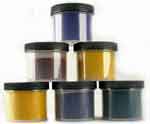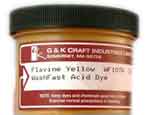Dylon fabric dye didn't work on nylon. Can you help?
Dylon fabric dye didn't work on nylon. Can you help?
Name: Megan
—ADVERTISEMENTS—

Lanaset Dyes are among the very best dyes for hand-dyeing wool, silk, angora, mohair, and most nylons. You will also need: citric acid, sodium acetate, Glauber salt, Albegal SET, and Synthrapol.
Buy from
Paradise Fibers
Washfast Acid dyes
at Paradise Fibers

Washfast Acid dyes
Also known as Nylomine dyes, excellent for use on nylon. One ounce of dye will dye six pounds of fiber!
at Paradise Fibers

Washfast Acid dyes
Also known as Nylomine dyes, excellent for use on nylon. One ounce of dye will dye six pounds of fiber!
Country or region: USA
Message: My daughter and I are making costumes for her young choreographer' s dance entry. When we went to the web site to order the bootie shorts, they didn't have enough of the colors she wanted... So we got the bright idea that we could handle this dye job....Wrong! $400.00 dollars later we have two dozen nylon bootie shorts that of course were dye resistant. Following the directions to a tee- we used Dylon fabric dye and recommended salt on low heat for a total of 60 minutes. When the blue washed away in the cold rinse, I put them back in the, now room temp, dye bath and left them over night. We are dying chocolate brown and tulip red as well. At this point all shorts have been simply pulled from their dye to dry without rinsing. I need advice on what to do without further compromising the spandex nature of the shorts and get some color. Can you help?
What kind of Dylon dye were you using? Dylon makes different kinds of dyes.
If you were using Dylon Permanent, then it's no wonder it didn't do anything. Dylon Permanent contains fiber reactive dye plus trisodium phosphate, a high-pH chemical that, like all high-pH chemicals, happens to prevent nylon from dyeing. Nylon is best dyed with acid dyes, in the presence of a mild acid such as vinegar. Other dyes, which don't contain high-pH chemicals, can often be made to work as acid dyes if you use vinegar, but the high-pH chemicals in Dylon Permanent will neutralize any acid you add, so you will end up with no acid at all, and no nylon dyeing.
On the other hand, Dylon Multi-Purpose dye is like Rit All-Purpose dye; both contain a mixture of dye types, including acid dyes, so both can work on nylon if used with vinegar. They're not the best acid dyes, but good enough for costumes, as long as they manage to produce the right color (sometimes the color is different in hue from what the package predicts). I don't think I've seen Dylon Multi Purpose dyes for sale in the US any time recently, though, so you probably have Dylon Permanent. It's sometimes possible to find Dylon Cold Dyes, which contain Procion MX dyes that can work on nylon if used with vinegar or another acid, leaving out the soda ash dye activator called for by the recipes for dyeing cotton. You need a different recipe for that, though.
Salt is not much use for dyeing nylon, by the way. What you need for nylon is vinegar.
The simplest solution would probably be to get some Rit dye, since it does contain acid dye, and some vinegar. Rit dye is expensive compared to many other dyes, since each packet of powder is sufficient for only one pound of dry fabric, but, if you're in a hurry, driving around to find enough boxes of the color of Rit dye you want may be faster than ordering online, which is what you usually have to do to get better acid dyes. There are better acid dyes, but in your case faster is undoubtedly more important than better.
Weigh a number of the pairs of shorts to find out how many it takes to make up a pound. (Weigh them while they are dry, not wet!) Buy at least one packet of Rit or Tintex all-purpose dye for each pound of dry fabric, or one bottle of the liquid dye for two pounds of fabric. For paler colors, use less dye per pound of fabric; for darker or more intense colors, including brown or red, use twice as much dye.
Since you don't want to damage the spandex, don't heat the dyebath to the ideal temperature for dyeing nylon (normally around 185°F); see if hot water will do the job, or even try first with merely warm water, depending on how concerned you are about the spandex. Use one cup of distilled white vinegar in three gallons of water. To encourage level dyeing, in which you get a solid color rather than a mottled one, wait until after the clothing has been in the dyebath for five minutes before adding the vinegar, include a tablespoon of laundry detergent in the dyebath, and stir frequently.
You must rinse clothing thoroughly before wearing it. Unrinsed dye will rub off even when the clothing is wet, ruining other clothing or furniture, and exposing people's skin to unwise quantities of dye powder.
I have to warn you that some nylons have a coating on them that you cannot feel, but which blocks dye. We don't yet know if this is a problem for your nylon shorts, because even perfectly dyeable nylon cannot be dyed with Dylon Permanent dye. We can hope that your shorts will dye well with acid dye. Dylon Permanent dye is very good for cotton, by the way, much better than Rit; it's not a bad dye, just not suitable for nylon.
(Please help support this web site. Thank you.)
(Please help support this web site. Thank you.)
Posted: Tuesday - February 14, 2012 at 03:06 PM
Follow this blog on twitter here.
Quick Links
- All About Dyes & Dyeing Top -
- Top of this blog -
- FAQ -
- The Dye Forum -
- How to Tie Dye - How to Batik -
- Books - Toys - Plants -
- Top of this blog -
- FAQ -
- The Dye Forum -
- How to Tie Dye - How to Batik -
- Books - Toys - Plants -
More in this category:
- -
Statistics
Total entries in this blog:
Total entries in this category:
Published On: Aug 29, 2012 02:49 PM
Total entries in this category:
Published On: Aug 29, 2012 02:49 PM